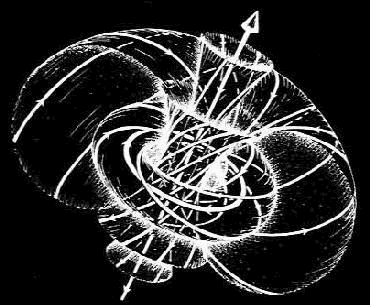|
14. Light
Light has been identified in religion
and science as the governing medium of the universe. This page will be updated
as new discoveries about the nature of light are made. Hopefully, they will
be enlightening!
A.) Biophotons:
Biophotons are weak electromagnetic
waves in the optical range of the spectrum that all living cells emit. They
cannot be seen by the naked eye but can be detected using special equipment.
It is believed that photons are stored in the molecules of the cell DNA. This
is a very new science and may revolutionize our understanding of life and light.
The phenomenon was recognized by Russian biologists in the early 1900's, but
didn't receive a lot of attention until the release of a book by Marco Bischof
in 1995. The book, titled Biophotons, was only published in German. A basic
overview of the book can be seen at:
http://www.starbuilders.org/fft/articles/biophoton.html.
A more recent work of the same title was published in 2002 by Kluwer Academic
Publishers. The editors are Jiin-Ju Chang, Joachim, and Fritz-Albert Popp. This
is condensed from a series of papers presented at a symposium at the International
Institute of Biophysics in Neuss, Germany in 1997. Watch for more to come!
B.) Light and Consciousness:
Peter Russell is an author who has
a degree in physics and experimental psychology. He has also studied Eastern
philosophy. In his book, From Science to God, he describes similarities in the
characteristics of light and consciousness. He concludes that nervous systems
are not creators of consciousness, but are simply amplifiers of it, and postulates
that the source of all consciousness may be the light that permeates the universe.
http://www.peterrussell.com/
C.) Twisters:
Physicists have been trying for years to unify the laws governing very small things, such as subatomic particles, and very large things, like stars and planets.
Einstein spent his final years struggling, unsuccessfully, with this question.
It is interesting to note that the characteristics of light are what triggered his entire theory of relativity.
It is not surprising, therefore, that understanding light is the key to understanding the nature of the universe.
In the 1960"s, Oxford Physicist Roger Penrose developed a radical new way to develop a unified theory.
Instead of trying to explain how subatomic particles move and interact within space and time, he postulated that space and time might arise from a deeper level of reality.
He thought that reality might be represented by a so- called "twister."
In this theory, light is central.
It is thought that rays of light might be twisted, or rotated around to produce what we know as particles of matter.
The twisting is mathematically represented by a Robinson congruence (see diagram below).
In recent years, string theorists, who are closest to finding a unified theory in physics, have found a correlation in twisters.
String theorist Nima Arkani-Hamed said: "I have never been more excited about physics in my life.
It is developing at a blistering pace right now, with a group of roughly 15 people in the world working on it night and day." 1
Intriguingly, Arthur Young's process theory of 1976 predicted that the universe would be described as toroidal in shape.
The Robinson congruence is, in fact, a complex torus. (See the Reflexive Universe, by Arthur Young, p. 265-266)
 2 2
Notes:
- A Simple Twist of Fate, by George Musser, Scientific American, June 2010, p. 14
- On the Origins of Twister Theory, by Robert Penrose. Gravitation and Geometry, a Volume in Honor of I. Robinson, Bibliopolis, Naples 1987
|
 2
2